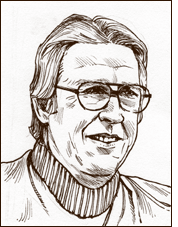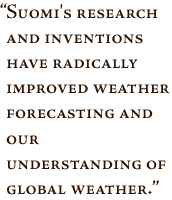

by Russell Hall • October 30, 2001 Space Science and Engineering Center, University of Wisconsin-Madison | |||

“You’ve certainly gotten a lot of mileage out of freshman physics.” According to Dr. Verner Suomi, this was a comment he heard more than once over the course of his career and he was proud of it. Using a unique combination of determination, hard work, inspiration, and those freshman physics, Suomi became known as the “father of satellite meteorology.” His research and inventions have radically improved forecasting and our understanding of global weather. Verner Suomi didn’t set out to invent satellite meteorology. In fact, he described his education as “a mess.” Growing up in Minnesota, he wanted to be an engineer. But with finances limiting his choices for higher education, he wound up at Winona State University, a teacher’s college in Winona, Minnesota. After teaching high school science for several years, he enrolled in a Civil Air Patrol course at the start of World War II. There, he got his first exposure to the new field of meteorology. This new love led him to the University of Chicago, where he continued his meteorology studies and trained air cadets in basic forecasting. By 1948 he was one of the first faculty members in the Department of Meteorology at the University of Wisconsin in Madison, an institution at which he would spend most of his professional life. Suomi received his Ph.D. from the University of Chicago in 1953. For his doctoral thesis, he measured the heat budget of a cornfield; a subject that Suomi himself admitted was none too glamorous. But measuring the difference between the amount of energy absorbed and the amount of energy lost in a cornfield led him to thinking about Earth’s heat budget. The obvious way to measure such a thing was to use satellites, which, by the mid-1950s, were emerging as a meteorological tool. “When I first began my work with meteorological satellites, no one in the Department of Meteorology seemed particularly interested; but they didn’t try to impede progress in the field for which I’m forever thankful.”
By 1959 Suomi’s flat plate radiometer was in orbit. Using both satellite observations of the Earth’s heat balance and atmospheric cooling rates measured by net flux radiometersondes on weather balloons, Suomi established the important role played by clouds in absorbing radiated solar energy. These studies set the stage for the full-scale integration of satellites into the field of meteorology. next: Suomi’s gadgets |
 On the Shoulders of Giants
Related Sites
Top: A portrait of Verner Suomi. (Drawing by Roger Kammerer) | ||